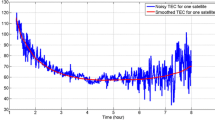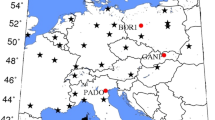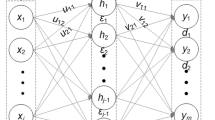Abstract
Computerized tomography provides valuable information for imaging the ionospheric electron density distribution. We use a wavelet neural network with a particle swarm optimization training algorithm to solve pixel-based ionospheric tomography. This new method is called ionospheric tomography based on the neural network (ITNN). In this method, vertical and horizontal objective functions are minimized. Due to a poor vertical resolution of ionospheric tomography, empirical orthogonal functions are used as vertical objective function. For numerical experimentation, observations collected at 38 GPS stations on 2 days in 2007 (April 3 and July 13) from the Iranian permanent GPS network (IPGN) are used. Ionosonde observations (φ = 35.7382°, λ = 51.3851°) are used for validating the reliability of the proposed method. The modeling region is between 24°E to 40°E and 44°N to 64°N. The results of the ITNN method have been compared to those of the international reference ionosphere model 2012 (IRI-2012) and the spherical cap harmonics (SCHs) method as a local model. The minimum relative error for ITNN is 1.41% and the maximum relative error is 24.03%. Also, the root-mean-square error of 0.1932 × 1011 (el/m3) has been computed for ITNN, which is less than the RMSE of the IRI-2012 and SCHs method. The comparison of ITNN results with IRI-2012 and SCHs method shows that the proposed approach is superior to those of the traditional methods.












Similar content being viewed by others
References
Austen JR, Franke SJ, Liu CH (1988) Ionospheric imaging using computerized tomography. Radio Sci 23(03):299–307. doi:10.1029/RS023i003p00299
Bilitza D, Reinisch BW (2008) International reference ionosphere 2007: improvements and new parameters. Adv Space Res 42(4):599–609. doi:10.1016/j.asr.2007.07.048
Bjornsson H, Venegas SA (1997) A manual for EOF and SVD analyses of climate data. Department of Atmospheric and Oceanic Sciences and Center for Climate and Global Change Research, McGill University, February, 1997, 53
Cander R (1998) Artificial neural network applications in ionospheric studies. Ann Geofis 41(5–6):757–766. doi:10.4401/ag-3817
Chen Y, Yanga B, Dong J (2006) Time-series prediction using a local linear wavelet neural network. Neurocomputing 69(4–6):449–465. doi:10.1016/j.neucom.2005.02.006
Ciraolo L, Azpilicueta F, Brunini C, Meza A, Radicella SM (2007) Calibration errors on experimental slant total electron content (TEC) determined with GPS. J Geodesy 81(2):111–120. doi:10.1007/s00190-006-0093-1
El-Arini MB, Conker RS, Albertson TW, Reagan JK, Klobuchar JA, Doherty PH (1995) Comparison of real-time ionosphere algorithms for a GPS Wide-Area Augmentation System (WAAS). Navigation 41(4):393–413. doi:10.1002/j.2161-4296.1994.tb01887.x
Fortier N, Sheppard J, Pillai K (2012) DOSI: Training artificial neural networks using overlapping swarm intelligence with local credit assignment. In: Soft computing and intelligent systems (SCIS) and 13th international symposium on advanced intelligent systems (ISIS), pp 1420–1425, doi:10.1109/SCIS-ISIS.2012.6505078
Gao Y, Liao X, Liu ZZ (2002) Ionosphere modeling using carrier smoothed ionosphere observations from a regional GPS network. Geomatica 56(2):97–106
Ghaffari Razin MR (2015) Development and analysis of 3D ionosphere modeling using base functions and GPS data over Iran. Acta Geod Geophys 51(1):95–111. doi:10.1007/s40328-015-0113-9
Ghaffari Razin MR, Voosoghi B (2016a) Regional ionosphere modeling using spherical cap harmonics and empirical orthogonal functions over Iran. Acta Geod Geophys 52(1):19–33. doi:10.1007/s40328-016-0162-8
Ghaffari Razin MR, Voosoghi B (2016b) Regional application of multi-layer artificial neural networks in 3D ionosphere tomography. Adv Space Res 58(3):339–348. doi:10.1016/j.asr.2016.04.029
Ghaffari Razin MR, Voosoghi B (2016c) Wavelet neural networks using particle swarm optimization training in modeling regional ionospheric total electron content. J Atmos Solar Terr Phys 149(2016):21–30. doi:10.1016/j.jastp.2016.09.005
Habarulema JB, McKinnell L-A, Opperman BDL (2009) A recurrent neural network approach to quantitatively studying solar wind effects on TEC derived from GPS; preliminary results. Ann Geophys 27(11):2111–2125. doi:10.5194/angeo-27-2111-2009
Haines GV (1988) Computer programs for spherical cap harmonic analysis of potential and general fields. Comput Geosci 14(4):413–447. doi:10.1016/0098-3004(88)90027-1
Kennedy J, Eberhart R (1995) Particle swarm optimization. In: Proceedings of the IEEE international conference on neural networks, 4(ICNN’95): 1942–1948, Perth, Western Australia, November–December 1995
Klobuchar J.A (1975) A first-order worldwide ionospheric time delay algorithm. Air Force Cambridge Research Laboratories. Hanscom, AFB, MA, AFCRL-TR-75-0502, AD A018862
Komjathy A, Langley RB (1996) An assessment of predicted and measured ionospheric total electron content using a regional GPS network. In: Proc. ION NTM 1996, Institute of Navigation, Santa Monica, CA, 22–24 January, pp 615–624
Kunitsyn VE, Nesterov IA, Padokhin AM, Tumanova US (2011) Ionospheric radio tomography based on the GPS/GLONASS navigation systems. J Commun Technol Electron 56(11):1269–1281. doi:10.1134/S1064226911100147
Liu Z, Gao Y (2003) Ionospheric TEC predictions over a local area GPS reference network. GPS Solut 8(1):23–29. doi:10.1007/s10291-004-0082-x
Ma XF, Maruyama T, Ma G, Takeda T (2005) Three dimensional ionospheric tomography using observation data of GPS ground receivers and ionosonde by neural network. J Geophys Res 110(A05308):1–12. doi:10.1029/2004JA010797
McKinnell LA, Poole AWV (2004) Neural network based ionospheric modeling over the South African region. S Afr J 100(11–12):519–523
Pokhotelov D, Jayachandran P, Mitchell CN, MacDougall JW, Denton MH (2011) GPS tomography in the polar cap: comparison with ionosondes and in situ spacecraft data. GPS Solut 15(1):79–87. doi:10.1007/s10291-010-0170-z
Quarteroni A, Sacco R, Saleri F (2007) Numerical mathematics, vol 37. Texts in applied mathematics, 2nd edn. Springer, Berling
Schaer S (1999) Mapping and predicting the earths ionosphere using the global positioning system. Ph.D. dissertation, Astronomical Institute, University of Berne, Switzerland, p 205
Van de Kamp MMJL (2013) Medium-scale 4D ionospheric tomography using a dense GPS network. Ann Geophys 31(1):75–89. doi:10.5194/angeo-31-75-2013
Wen DB, Wang Y, Norman R (2012) A new two-step algorithm for ionospheric tomography solution. GPS Solut 16(1):89–94. doi:10.1007/s10291-011-0211-2
Yao Y, Tang J, Kong J (2015) New ionosphere tomography algorithm with two-grid virtual observations constraints and three-dimensional velocity profile. IEEE Trans Geosci Remote Sens 53(5):2373–2383. doi:10.1109/TGRS.2014.2359762
Yilmaz A, Akdogan KE, Gurun M (2009) Regional TEC mapping using neural networks. Radio Sci 44(3):1–16. doi:10.1029/2008RS004049
Yizengaw E, Moldwina MB, Dysonb PL, Essexb EA (2006) Using tomography of GPS TEC to routinely determine ionospheric average electron density profile. J Atmos Solar Terr Phys 69(3):314–321. doi:10.1016/j.jastp.2006.07.023
Zhang Q, Benveniste A (1992) Wavelet networks. IEEE Trans Neural Netw 3(6):889–898. doi:10.1109/72.165591
Author information
Authors and Affiliations
Corresponding author
Rights and permissions
About this article
Cite this article
Ghaffari Razin, MR., Voosoghi, B. Ionosphere tomography using wavelet neural network and particle swarm optimization training algorithm in Iranian case study. GPS Solut 21, 1301–1314 (2017). https://doi.org/10.1007/s10291-017-0614-9
Received:
Accepted:
Published:
Issue Date:
DOI: https://doi.org/10.1007/s10291-017-0614-9




